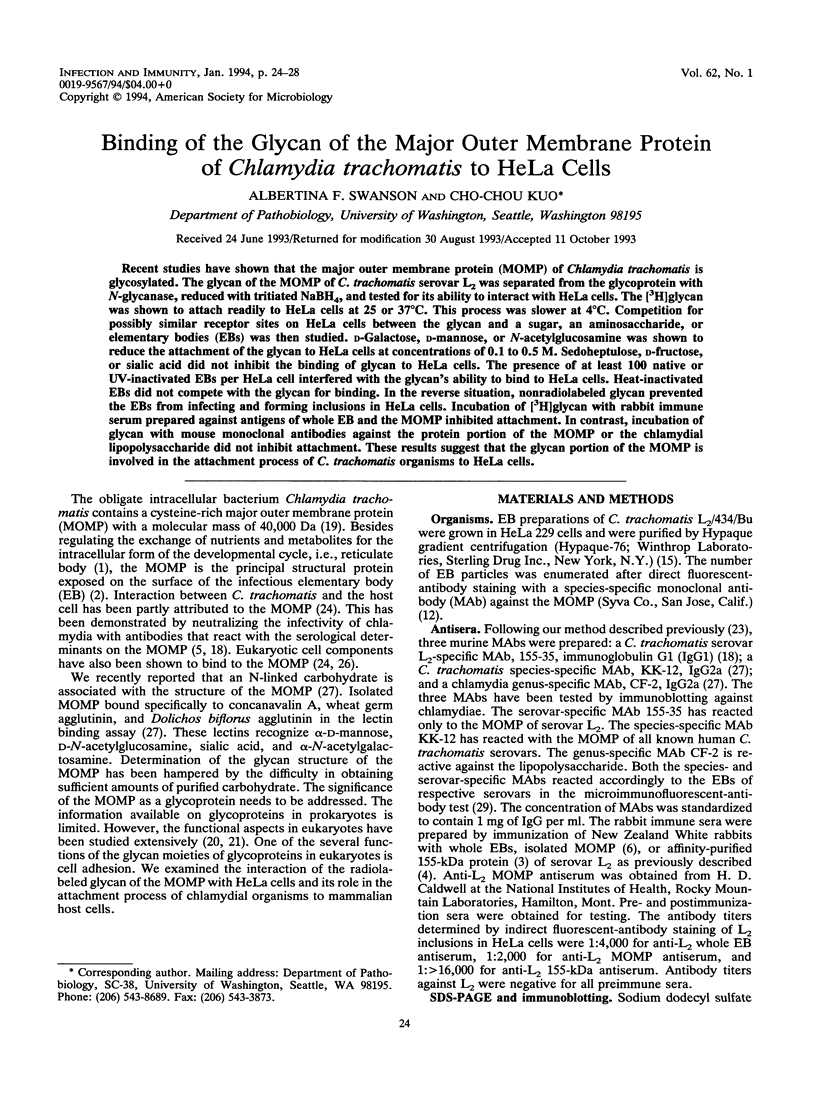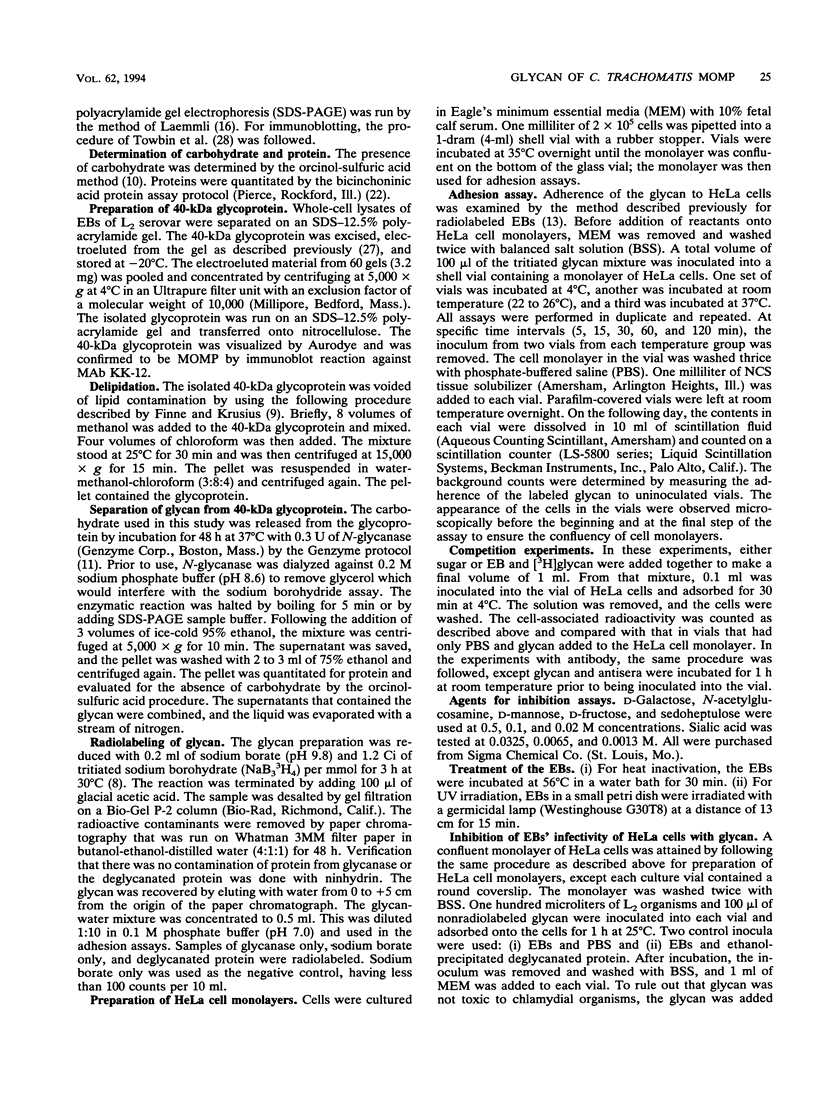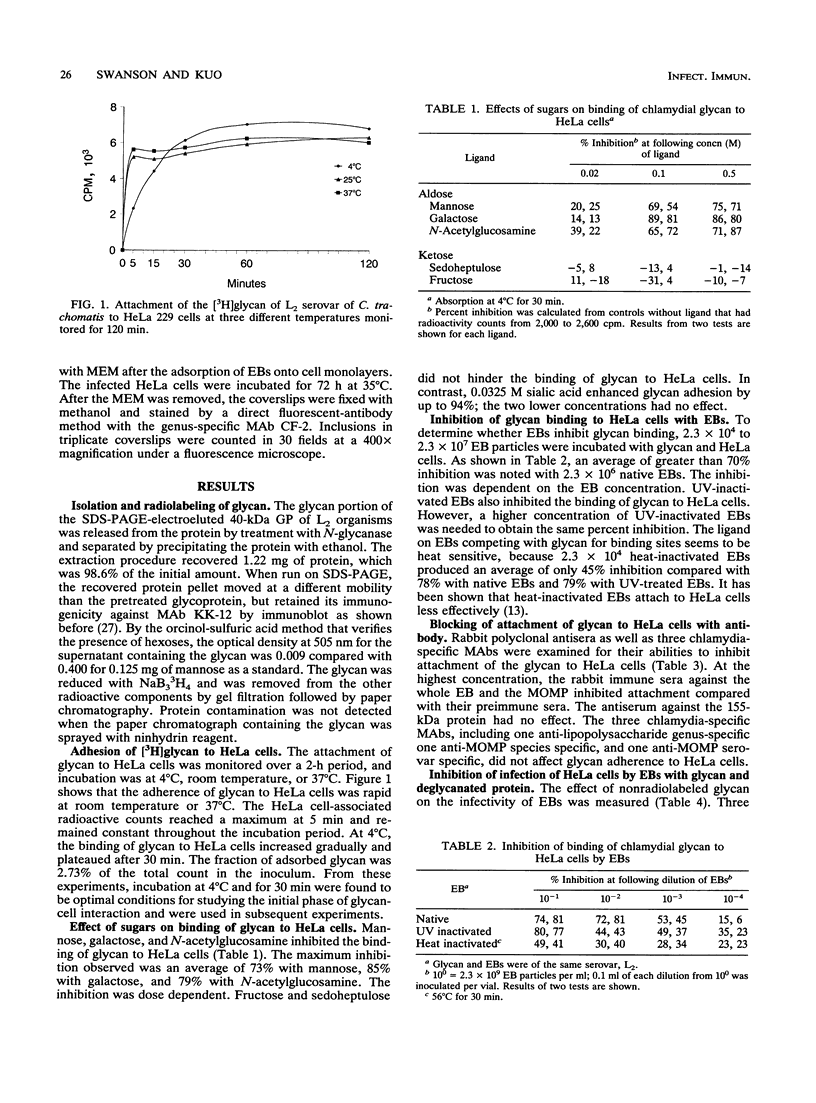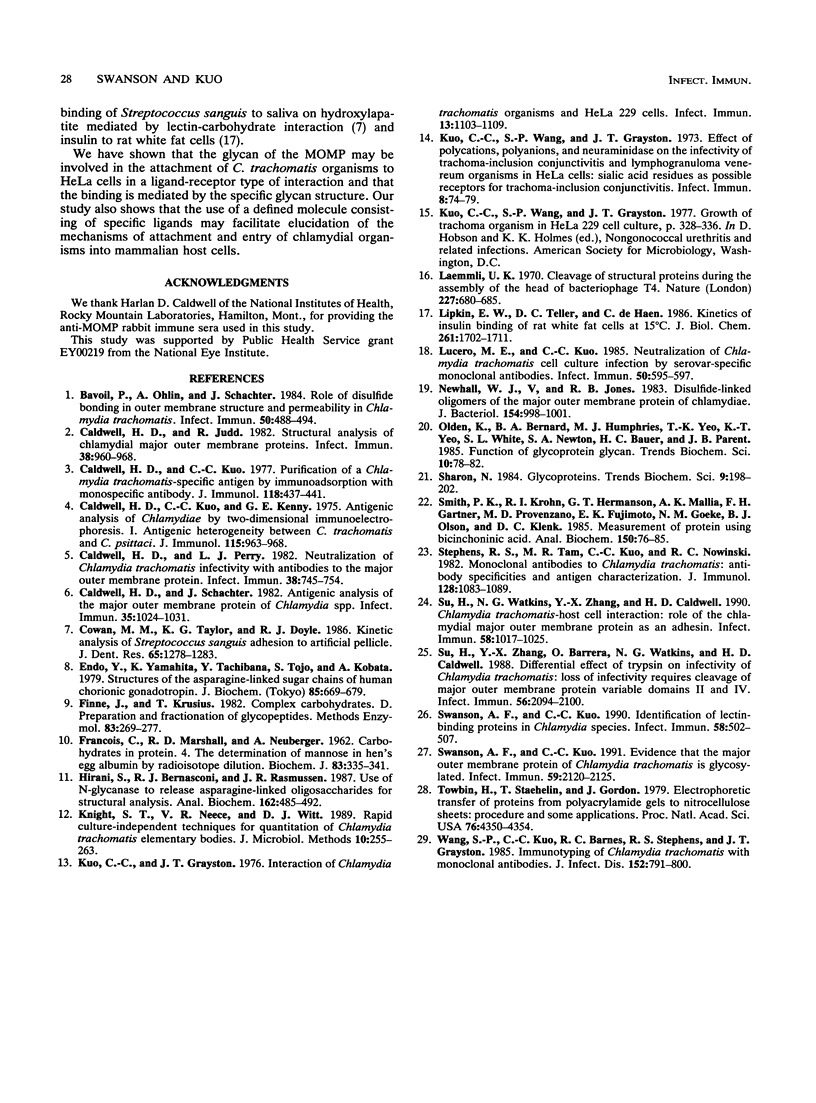Abstract
Recent studies have shown that the major outer membrane protein (MOMP) of Chlamydia trachomatis is glycosylated. The glycan of the MOMP of C. trachomatis serovar L2 was separated from the glycoprotein with N-glycanase, reduced with tritiated NaBH4, and tested for its ability to interact with HeLa cells. The [3H]glycan was shown to attach readily to HeLa cells at 25 or 37 degrees C. This process was slower at 4 degrees C. Competition for possibly similar receptor sites on HeLa cells between the glycan and a sugar, an aminosaccharide, or elementary bodies (EBs) was then studied. D-Galactose, D-mannose, or N-acetylglucosamine was shown to reduce the attachment of the glycan to HeLa cells at concentrations of 0.1 to 0.5 M. Sedoheptulose, D-fructose, or sialic acid did not inhibit the binding of glycan to HeLa cells. The presence of at least 100 native or UV-inactivated EBs per HeLa cell interfered with the glycan's ability to bind to HeLa cells. Heat-inactivated EBs did not compete with the glycan for binding. In the reverse situation, nonradiolabeled glycan prevented the EBs from infecting and forming inclusions in HeLa cells. Incubation of [3H]glycan with rabbit immune serum prepared against antigens of whole EB and the MOMP inhibited attachment. In contrast, incubation of glycan with mouse monoclonal antibodies against the protein portion of the MOMP or the chlamydial lipopolysaccharide did not inhibit attachment. These results suggest that the glycan portion of the MOMP is involved in the attachment process of C. trachomatis organisms to HeLa cells.
Full text
PDF




Selected References
These references are in PubMed. This may not be the complete list of references from this article.
- Caldwell H. D., Judd R. C. Structural analysis of chlamydial major outer membrane proteins. Infect Immun. 1982 Dec;38(3):960–968. doi: 10.1128/iai.38.3.960-968.1982. [DOI] [PMC free article] [PubMed] [Google Scholar]
- Caldwell H. D., Kuo C. C., Kenny G. E. Antigenic analysis of Chlamydiae by two-dimensional immunoelectrophoresis. I. Antigenic heterogeneity between C. trachomatis and C. psittaci. J Immunol. 1975 Oct;115(4):963–968. [PubMed] [Google Scholar]
- Caldwell H. D., Kuo C. C. Purification of a Chlamydia trachomatis-specific antigen by immunoadsorption with monospecific antibody. J Immunol. 1977 Feb;118(2):437–441. [PubMed] [Google Scholar]
- Caldwell H. D., Perry L. J. Neutralization of Chlamydia trachomatis infectivity with antibodies to the major outer membrane protein. Infect Immun. 1982 Nov;38(2):745–754. doi: 10.1128/iai.38.2.745-754.1982. [DOI] [PMC free article] [PubMed] [Google Scholar]
- Caldwell H. D., Schachter J. Antigenic analysis of the major outer membrane protein of Chlamydia spp. Infect Immun. 1982 Mar;35(3):1024–1031. doi: 10.1128/iai.35.3.1024-1031.1982. [DOI] [PMC free article] [PubMed] [Google Scholar]
- Cowan M. M., Taylor K. G., Doyle R. J. Kinetic analysis of Streptococcus sanguis adhesion to artificial pellicle. J Dent Res. 1986 Oct;65(10):1278–1283. doi: 10.1177/00220345860650101501. [DOI] [PubMed] [Google Scholar]
- Endo Y., Yamashita K., Tachibana Y., Tojo S., Kobata A. Structures of the asparagine-linked sugar chains of human chorionic gonadotropin. J Biochem. 1979 Mar;85(3):669–679. [PubMed] [Google Scholar]
- FRANCOIS C., MARSHALL R. D., NEUBERGER A. Carbohydrates in protein. 4. The determination of mannose in hen's-egg albumin by radioisotope dilution. Biochem J. 1962 May;83:335–341. doi: 10.1042/bj0830335. [DOI] [PMC free article] [PubMed] [Google Scholar]
- Finne J., Krusius T. Preparation and fractionation of glycopeptides. Methods Enzymol. 1982;83:269–277. doi: 10.1016/0076-6879(82)83020-6. [DOI] [PubMed] [Google Scholar]
- Hirani S., Bernasconi R. J., Rasmussen J. R. Use of N-glycanase to release asparagine-linked oligosaccharides for structural analysis. Anal Biochem. 1987 May 1;162(2):485–492. doi: 10.1016/0003-2697(87)90424-6. [DOI] [PubMed] [Google Scholar]
- Kuo C. C., Grayston T. Interaction of Chlamydia trachomatis organisms and HeLa 229 cells. Infect Immun. 1976 Apr;13(4):1103–1109. doi: 10.1128/iai.13.4.1103-1109.1976. [DOI] [PMC free article] [PubMed] [Google Scholar]
- Kuo C. C., Wang S. P., Grayston J. T. Effect of polycations, polyanions and neuraminidase on the infectivity of trachoma-inclusin conjunctivitis and lymphogranuloma venereum organisms HeLa cells: sialic acid residues as possible receptors for trachoma-inclusion conjunction. Infect Immun. 1973 Jul;8(1):74–79. doi: 10.1128/iai.8.1.74-79.1973. [DOI] [PMC free article] [PubMed] [Google Scholar]
- Laemmli U. K. Cleavage of structural proteins during the assembly of the head of bacteriophage T4. Nature. 1970 Aug 15;227(5259):680–685. doi: 10.1038/227680a0. [DOI] [PubMed] [Google Scholar]
- Lipkin E. W., Teller D. C., de Haën C. Kinetics of insulin binding to rat white fat cells at 15 degrees C. J Biol Chem. 1986 Feb 5;261(4):1702–1711. [PubMed] [Google Scholar]
- Lucero M. E., Kuo C. C. Neutralization of Chlamydia trachomatis cell culture infection by serovar-specific monoclonal antibodies. Infect Immun. 1985 Nov;50(2):595–597. doi: 10.1128/iai.50.2.595-597.1985. [DOI] [PMC free article] [PubMed] [Google Scholar]
- Newhall W. J., Jones R. B. Disulfide-linked oligomers of the major outer membrane protein of chlamydiae. J Bacteriol. 1983 May;154(2):998–1001. doi: 10.1128/jb.154.2.998-1001.1983. [DOI] [PMC free article] [PubMed] [Google Scholar]
- Smith P. K., Krohn R. I., Hermanson G. T., Mallia A. K., Gartner F. H., Provenzano M. D., Fujimoto E. K., Goeke N. M., Olson B. J., Klenk D. C. Measurement of protein using bicinchoninic acid. Anal Biochem. 1985 Oct;150(1):76–85. doi: 10.1016/0003-2697(85)90442-7. [DOI] [PubMed] [Google Scholar]
- Stephens R. S., Tam M. R., Kuo C. C., Nowinski R. C. Monoclonal antibodies to Chlamydia trachomatis: antibody specificities and antigen characterization. J Immunol. 1982 Mar;128(3):1083–1089. [PubMed] [Google Scholar]
- Su H., Watkins N. G., Zhang Y. X., Caldwell H. D. Chlamydia trachomatis-host cell interactions: role of the chlamydial major outer membrane protein as an adhesin. Infect Immun. 1990 Apr;58(4):1017–1025. doi: 10.1128/iai.58.4.1017-1025.1990. [DOI] [PMC free article] [PubMed] [Google Scholar]
- Su H., Zhang Y. X., Barrera O., Watkins N. G., Caldwell H. D. Differential effect of trypsin on infectivity of Chlamydia trachomatis: loss of infectivity requires cleavage of major outer membrane protein variable domains II and IV. Infect Immun. 1988 Aug;56(8):2094–2100. doi: 10.1128/iai.56.8.2094-2100.1988. [DOI] [PMC free article] [PubMed] [Google Scholar]
- Swanson A. F., Kuo C. C. Evidence that the major outer membrane protein of Chlamydia trachomatis is glycosylated. Infect Immun. 1991 Jun;59(6):2120–2125. doi: 10.1128/iai.59.6.2120-2125.1991. [DOI] [PMC free article] [PubMed] [Google Scholar]
- Swanson A. F., Kuo C. C. Identification of lectin-binding proteins in Chlamydia species. Infect Immun. 1990 Feb;58(2):502–507. doi: 10.1128/iai.58.2.502-507.1990. [DOI] [PMC free article] [PubMed] [Google Scholar]
- Towbin H., Staehelin T., Gordon J. Electrophoretic transfer of proteins from polyacrylamide gels to nitrocellulose sheets: procedure and some applications. Proc Natl Acad Sci U S A. 1979 Sep;76(9):4350–4354. doi: 10.1073/pnas.76.9.4350. [DOI] [PMC free article] [PubMed] [Google Scholar]
- Wang S. P., Kuo C. C., Barnes R. C., Stephens R. S., Grayston J. T. Immunotyping of Chlamydia trachomatis with monoclonal antibodies. J Infect Dis. 1985 Oct;152(4):791–800. doi: 10.1093/infdis/152.4.791. [DOI] [PubMed] [Google Scholar]


